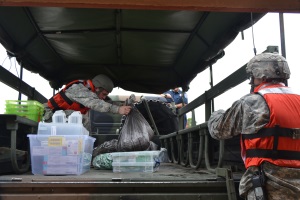Sense of Service in Texans' Blood, Deeper than Water
Texas National Guard Supports Health Department Supply Mission
Story by: Tech. Sgt. Shawn McCowan, 147th Reconnaissance Wing Public Affairs
 Hundreds of Texans left their normal daily routine in mid-March to collectively help those affected by recent flooding in Orange, Texas. Orange County Emergency Management staff were joined by members of organizations like the local Red Cross, law enforcement, fire and rescue, various units from the Texas Military Department, and many others.
Hundreds of Texans left their normal daily routine in mid-March to collectively help those affected by recent flooding in Orange, Texas. Orange County Emergency Management staff were joined by members of organizations like the local Red Cross, law enforcement, fire and rescue, various units from the Texas Military Department, and many others.
While this team was dedicated to rescue and support residents, some situations required them to provide a helping hand to each other.
Flooding forced the evacuation of the Orange County Health Department. But once workers were safe from the rising waters, someone had to return to retrieve vital medical supplies they would need to help injured evacuees.
Sabrina Davis, a Registered Nurse with the county health department, volunteered to return to get as many supplies as possible, but she couldn't get there alone. Members of the 551st Multi-Role Bridge Co., 386th Engineer Battalion, 176th Engineer Brigade stepped up to get her safely through the high waters.
Davis was escorted by SPC Gabriel Torres, a member of 551 MRBC, who helped carry and load alcohol pads, syringes, bandages, gloves, and many other daily-use medical items. She recognized the importance of what could have seemed like a basic chauffeur trip.
"I am very thankful these Texas Guard members are here to help. We really need these supplies at our local shelters and other support locations. The health department couldn't help anyone without the things we retrieved. This is a terrible situation Orange is experiencing, but it is great to see us coming together together like this," said Davis.
Even the seemingly simple supply run reinforced the definition of the Texas Guard mission, "Texans helping Texans."
My VIRIN - 160317-Z-UZ218-
DSC_3343 - 551st Into the Deluge - A vehicle operator with the 551st Multi-Role Bridge Co., 386th Engineer Battalion, 176th Engineer Brigade prepares to drive into the flooded city of Orange, Texas, March 17, 2016. The 551 MRBC stepped up to retrieve medic
al supplies left behind during evacuations due to the high waters.
DSC_3357 - Reality Washes Over - Sabrina Davis, a Registered Nurse with the Orange County Health Department, takes a photo of her flooded building while aboard a vehicle operated by the 551st Multi-Role Bridge Co., 386th Engineer Battalion, 176th Engineer Brigade in Orange, Texas, March 17, 2016. The 551 MRBC stepped up to retrieve medical supplies left behind during evacuations due to the high waters.
DSC_3359 - Dry Doc - Sabrina Davis, a Registered Nurse with the Orange County Health Department, prepares to return to her flooded building while aboard a vehicle operated by the 551st Multi-Role Bridge Co., 386th Engineer Battalion, 176th Engineer Brigade in Orange, Texas, March 17, 2016, with the help of SPC Gabriel Torres, a member of 551 MRBC. The 551 MRBC stepped up to retrieve medical supplies left behind during evacuations due to the high waters.
DSC_3362 - Texas State and County Services Stick Together - Sabrina Davis, a Registered Nurse with the Orange County Health Department, and SPC Gabriel Torres, a member of the 551st Multi-Role Bridge Co., 386th Engineer Battalion, 176th Engineer Brigade, gather important medical supplies in Orange, Texas, March 17, 2016. The 551 MRBC stepped up to retrieve medical supplies left behind during evacuations due to the high waters.
DSC_3371 - That Sinking Feeling - Sabrina Davis, a Registered Nurse with the Orange County Health Department, inspects the flooded area and homes around her building after gathering vital medical supplies with the help of the 551st Multi-Role Bridge Co., 386th Engineer Battalion, 176th Engineer Brigade in Orange, Texas, March 17, 2016. The 551 MRBC stepped up to assist retrieve medical supplies left behind during evacuations due to the high waters.
DSC_3372 - That Sinking Feeling - Sabrina Davis, a Registered Nurse with the Orange County Health Department, inspects the flooded area and homes around her building after gathering vital medical supplies with the help of the 551st Multi-Role Bridge Co., 386th Engineer Battalion, 176th Engineer Brigade in Orange, Texas, March 17, 2016. The 551 MRBC stepped up to assist Davis retrieve medical supplies left behind during evacuations due to the high waters.